Mysterious Chachapoyas ‘Warriors Of The Clouds’ And Their Impressive Structures
A.Sutherland - AncientPages.com - The Chachapoyas culture, settled in the Department of Amazonas, has left a significant number of large stone monuments, such as a massive stone citadel and a remote place, Kuelap that was discovered sixty years before the famous Machu Picchu, with more than four hundred buildings and cyclopean stone walls.
Chachapoyas: Inside the fortress of Kuelap. Image credit: Adobe Stock - Rafal Cichawa
Another landmark of the Chachapoyas land is the Great Pajatén, an archaeological site with a series of at least 26 circular stone structures atop numerous terraces and stairways, and the Laguna de Los Condores located at an altitude of 2,600 meters above sea level.
The Chachapoyas were called 'Cloud People' because they made their home among the cloud-covered tropical rainforests of the Amazon, lining the eastern slopes of the Andes mountains.
This ancient, fascinating, and rather unknown culture left impressive stone citadels, fantastic mausoleums, and sarcophagi built in almost inaccessible places. It was a culture in which communities developed autonomously and in an environment that significantly isolated them from other people.
The Chachapoyas culture had characteristic circular buildings decorated with friezes and high defensive walls. Despite its inaccessible location, the territory of the Chachapoyas was extensive. It formed a large triangular space formed by the confluence of the Marañón and Utcubamba rivers, up to the Abiseo Basin, where the ruins of the Great Pajatén rise.
The Chachapoyas sarcophagi, Peru. Image credit: Adobe Stock - barbarico
The culture's regular stone masonry constructions attest to the great skills of the Chachapoya builders who worked at the high altitude, raising the buildings on platforms and on slopes.
A good example can be Kuelap’s fortress with walls - sometimes decorated with symbolic figures nearly 600 meters in length and towers as high as 19 meters! Some stones weigh up to 3 tons. The Chachapoyas were indeed very hardworking people.
A Snake Symbol Represented By Zigzag
A snake symbol was among the Chachapoyas represented by zigzag, and it is considered the most widespread design of this ancient culture. However, there are many various symbols in the region inhabited by the Chachapoyas, and it isn't easy to recognize which ones were original and imposed by the Incas.
Despite this, Peter Lerche, a German - Peruvian anthropologist who mainly focused his research on the study of the Chachapoyas culture, has identified the three main figures of importance to the people of this period: represented in a large number of objects and places.
According to the chronicler Blas Valera, who began his life as a missionary and later wrote four important works defending Inca culture, religion, and language, the Chachapoyas worshiped snakes. The Condor was their main god. Lerche, on the other hand, proposed that the Condor was introduced
to this culture by the Incas.
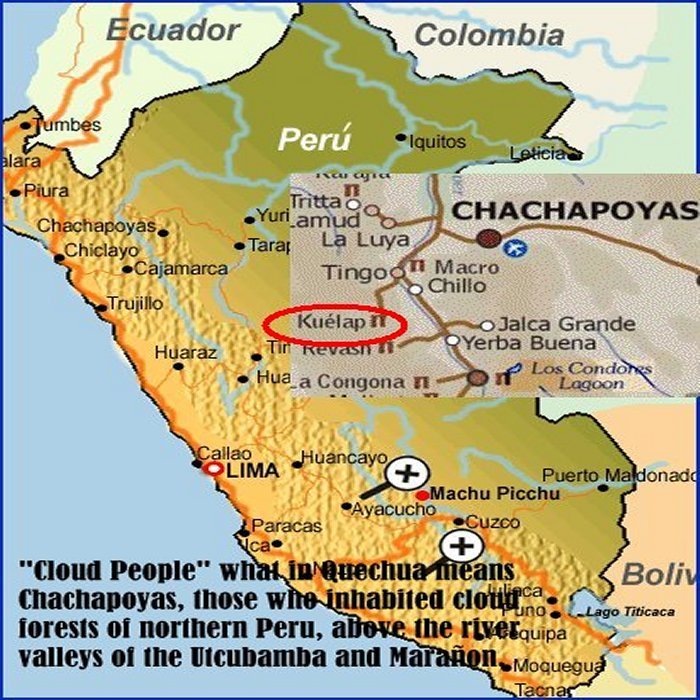
The snake is represented as a zigzag on the friezes of the circular buildings of the Chachapoyas. The zigzag is precisely the most widespread design in the geometric area controlled by the Chachapoyas, and the presence of this symbol in various mausoleums symbolized a relationship between the snake and the ancestors.
Another symbol related to the ancestors would be the shape of T used in some niches of the burial chambers. Two types of funerary traditions have been discovered among the Chachapoyas. The mausoleums of carved stone represent one, and another are the sarcophagi, both located in caves dug high in rocky ravines.
Their location made them practically inaccessible. The Chachapoyas also had large mausoleum constructions with two or three floors called Funeral Homes, with a gable roof, large quadrangular, or T-shaped niches.
Among the most famous structures in the land of the Chachapoyas are the burial tombs of the ancient "wise men." The tombs are located in an archaeological site, "Carajía," only 60 kilometers northeast of the city of Chachapoyas, in the Luya province, in Peru. Perched high on a very narrow horizontal surface projecting from the limestone cliff, the six sarcophagi (carved in stone) show limbless torsos with large heads and huge jawlines and chins up. In a way, they resemble monolithic monuments depicting human figures carved by the Rapa Nui people on Easter Island. Similar to the Chachapoyas figures, they look straight ahead into the distant horizon.
Some of their headdresses are adorned with horns, imitating deer horns, while others are inlaid with human skulls. Each Chachapoya sarcophagus has a height of 2.5 meters.
We know that the Inca Empire conquered this mysterious culture in the late 15th century.
Interestingly, the Chachapoyas remained genetically distinct and not assimilated by the Inca Empire and its expansion into this area hundreds of years ago.
Written by – A. Sutherland - AncientPages.com Senior Staff Writer
Copyright © AncientPages.com All rights reserved. This material may not be published, broadcast, rewritten or redistributed in whole or part without the express written permission of AncientPages.com
Expand for referencesReferences:
More From Ancient Pages
-
 On This Day In History: Berlin Victory Parade Took Place – On September 7, 1945
News | Sep 7, 2016
On This Day In History: Berlin Victory Parade Took Place – On September 7, 1945
News | Sep 7, 2016 -
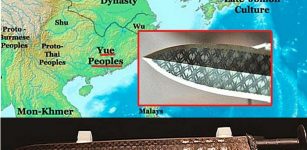 Superior Sword Of Goujian: Jian Weapon And Legend Of Immortal With Good Advice
Artifacts | Oct 15, 2019
Superior Sword Of Goujian: Jian Weapon And Legend Of Immortal With Good Advice
Artifacts | Oct 15, 2019 -
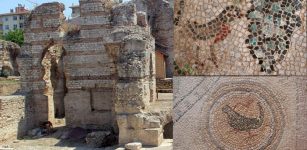 Beautiful Zeugma-Like Mosaics Unearthed In Sinop Province, Northern Turkey
Archaeology | Oct 17, 2020
Beautiful Zeugma-Like Mosaics Unearthed In Sinop Province, Northern Turkey
Archaeology | Oct 17, 2020 -
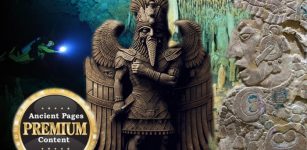 Evidence Of An Unknown Ancient Civilization In The Yucatan?
Featured Stories | Apr 6, 2024
Evidence Of An Unknown Ancient Civilization In The Yucatan?
Featured Stories | Apr 6, 2024 -
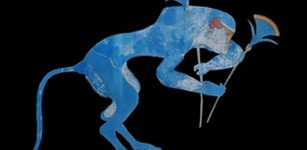 Mystery Of The Minoan Blue Monkeys Depicted In Frescoes
Archaeology | Apr 16, 2020
Mystery Of The Minoan Blue Monkeys Depicted In Frescoes
Archaeology | Apr 16, 2020 -
 On This Day In History: Michael Servetus Burned At The Stake ‘Atop A Pyre Of His Own Books’ – On Oct 27, 1553
News | Oct 26, 2016
On This Day In History: Michael Servetus Burned At The Stake ‘Atop A Pyre Of His Own Books’ – On Oct 27, 1553
News | Oct 26, 2016 -
 England’s Oldest Bible Reveals Surprising Hidden Secrets
Biblical Mysteries | Mar 19, 2016
England’s Oldest Bible Reveals Surprising Hidden Secrets
Biblical Mysteries | Mar 19, 2016 -
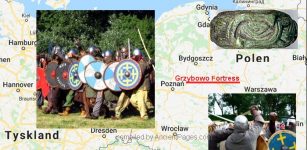 Medieval Ring Found In Piast Stronghold Near Gniezno, Poland – Is A Unique Christian Artifact
Archaeology | Nov 28, 2019
Medieval Ring Found In Piast Stronghold Near Gniezno, Poland – Is A Unique Christian Artifact
Archaeology | Nov 28, 2019 -
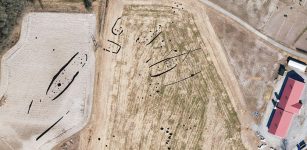 60-Meter Longhouse Discovered Near Viking Ship At Gjellestad, Norway
Archaeology | Dec 6, 2021
60-Meter Longhouse Discovered Near Viking Ship At Gjellestad, Norway
Archaeology | Dec 6, 2021 -
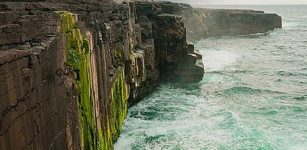 Intriguing Genetics: First Ancient Irish Human Genomes – Sequenced
Archaeology | Dec 29, 2015
Intriguing Genetics: First Ancient Irish Human Genomes – Sequenced
Archaeology | Dec 29, 2015 -
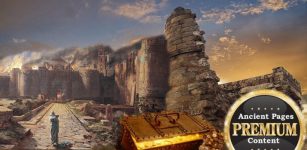 Lost Biblical City, Ancient Treasure And Atlantis – Biblical And Archaeological Perspective
Biblical Mysteries | Apr 27, 2018
Lost Biblical City, Ancient Treasure And Atlantis – Biblical And Archaeological Perspective
Biblical Mysteries | Apr 27, 2018 -
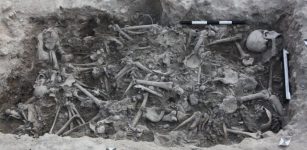 DNA Of Nine 13th Century Crusaders Provides A Glimpse Into Soldiers’ Life And Death
Archaeology | Apr 22, 2019
DNA Of Nine 13th Century Crusaders Provides A Glimpse Into Soldiers’ Life And Death
Archaeology | Apr 22, 2019 -
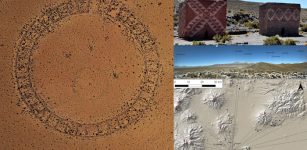 Mysterious Ancient Andean Waskiri Structure Built For Unknown Purpose Investigated By Scientists
Archaeology | Apr 14, 2023
Mysterious Ancient Andean Waskiri Structure Built For Unknown Purpose Investigated By Scientists
Archaeology | Apr 14, 2023 -
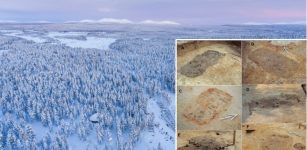 Mysterious Stone Age Cemetery Found Near The Arctic – Why Are The Graves Empty?
Archaeology | Dec 4, 2023
Mysterious Stone Age Cemetery Found Near The Arctic – Why Are The Graves Empty?
Archaeology | Dec 4, 2023 -
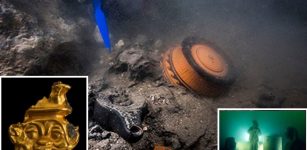 Ancient Underwater City Of Heracleion Reveals More Archaeological Treasures
Archaeology | Jul 21, 2021
Ancient Underwater City Of Heracleion Reveals More Archaeological Treasures
Archaeology | Jul 21, 2021 -
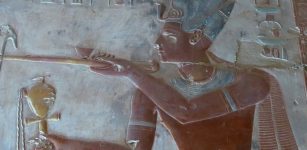 Seti I – Remarkable Pharaoh Who Saved The Kingdom Of Egypt And Gave It New Glory
Featured Stories | Jun 15, 2021
Seti I – Remarkable Pharaoh Who Saved The Kingdom Of Egypt And Gave It New Glory
Featured Stories | Jun 15, 2021 -
 Ancient DNA Solves The Mystery Of Mitochondrial Eve And Human Evolution?
Archaeology | Sep 21, 2022
Ancient DNA Solves The Mystery Of Mitochondrial Eve And Human Evolution?
Archaeology | Sep 21, 2022 -
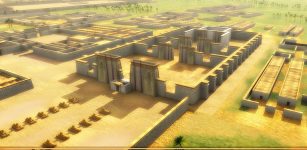 Ancient Egyptian Capital Tell El-Amarna Mapped Through Satellite Imagery System
Civilizations | Sep 11, 2015
Ancient Egyptian Capital Tell El-Amarna Mapped Through Satellite Imagery System
Civilizations | Sep 11, 2015 -
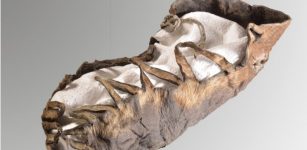 Extremely Well Preserved 2,000-Year-Old Child Shoe Discovered In Salt Mine
Archaeology | Sep 5, 2023
Extremely Well Preserved 2,000-Year-Old Child Shoe Discovered In Salt Mine
Archaeology | Sep 5, 2023 -
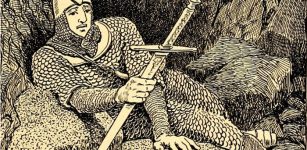 Durendal – Magical Sword Of Knight Roland That Cut Stone Boulders With A Single Strike
Featured Stories | Jan 19, 2022
Durendal – Magical Sword Of Knight Roland That Cut Stone Boulders With A Single Strike
Featured Stories | Jan 19, 2022


